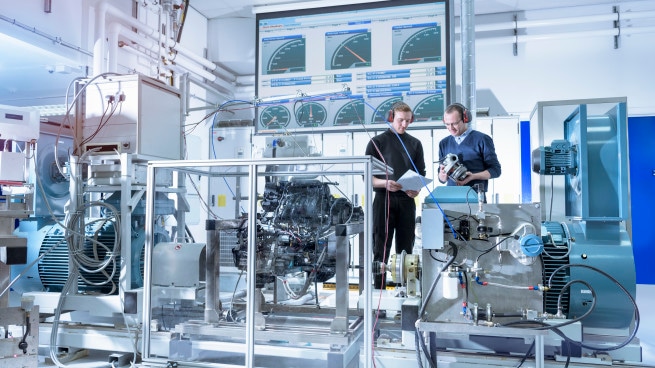{{item.title}}

Quantum computing (QC) is nothing but a new way of processing information. It can be best understood through a comparison with classical computing. While classical computing uses binary digits (bits) which have two values – 1 or 0 – QC uses quantum bits or qubits for computation. Qubits are any two-state quantum-mechanical system like electrons, photons, atoms and molecules that can represent 0s and 1s or various combinations of bits at the same time.
We are so used to classical computing in our day-to-day lives that we tend to ignore some of its shortcomings. Classical computing approaches problem solving in a sequential manner. This essentially means that there will be a direct correlation between the complexity of a problem and the time and computation power required to solve it. The advantage of this newer computational method is that qubits can perform parallel calculations through quantum mechanics, which in theory will make solving complex problems faster than with classical computers and have multiple applications of quantum computing in business.
QC is a new and exciting venture that most of the major tech giants are working on to make sure they have the first-mover advantage when the technology is scaled up. Aided by rapid development, QC is finding practical applications through which organisations can deliver value. To harness the true potential of this technology, however, it is important for businesses to collaborate with academia and governments. In 2021, the global market for QC technology was estimated to be USD 472 million, and it is expected to grow at a CAGR of 30.2% to reach a value of USD 1.76 billion by 2026.
QC has three distinct properties: superposition, entanglement and interference.
1. Superposition
While in classical computing, information is both discrete (only two states – 0s or 1s) and deterministic (will return the same output for a given input), in QC, the information stored is probabilistic. Qubits are either 1s, 0s or both at a given time. Before a value is read, qubits are in a superposition of an infinite number of possible states, and the value at any instant of time before the measurement is not fixed. But at the time of measurement, qubits follow the deterministic nature of bits, ending up in one of the two states (0s or 1s).
2. Entanglement
Quantum entanglement is a property where two particles (qubits) respond to each other without having a physical connection. While bits store information independent of each other, qubits store information as a group. To understand this better, let’s take the example of two coins spun on a table. The coins would come to a rest on either the head or tail face, and the final state of each of these coins is independent of the other. If these two coins were entangled, the moment we stopped one coin, the other coin would also stop spinning and show the same side vis-à-vis the first coin. This concept enables quantum computers to make use of parallel computing, enabling them to solve complex problems faster as compared to the serial computing of classical systems.
3. Interference
As per the inherent logic of QC, the solution to a problem is dynamic and probabilistic. The speed advantage of a quantum system comes from how quickly a quantum algorithm amplifies the correct answer and rejects the incorrect ones. The interference property enables the quantum algorithms to boost the potential solutions and weaken the wrong ones.
The efficacy of any emerging technology is evaluated through three factors: time, cost and quality. The properties of superposition, entanglement and interference, which underpin parallel computing, provide a speed advantage to QC in solving complex problems. QC thereby ticks two of the three boxes by saving time and cost for an organisation. Quality is one area in which QC lags behind, and a lot of research and development activities are being carried out to improve the quality and accuracy of the output to acceptable standards.
Classical computers are designed to go through each possible solution one by one, making them inappropriate for solving very large or complex problems. Using the concepts of superpositioning and entanglement, QC is able to go through many possible solutions (parallel computing) or perform a complex search in a matter of seconds or minutes. This speed advantage translates to potential business value for enterprises trying to solve problems related to optimisation, unstructured search and machine learning, and these are the fields in which QC has yet to be explored.
The efficacy of any emerging technology is evaluated through three factors: time, cost and quality. The properties of superposition, entanglement and interference, which underpin parallel computing, provide a speed advantage to QC in solving complex problems. QC thereby ticks two of the three boxes by saving time and cost for an organisation. Quality is one area in which QC lags behind, and a lot of research and development activities are being carried out to improve the quality and accuracy of the output to acceptable standards.
Classical computers are designed to go through each possible solution one by one, making them inappropriate for solving very large or complex problems. Using the concepts of superpositioning and entanglement, QC is able to go through many possible solutions (parallel computing) or perform a complex search in a matter of seconds or minutes. This speed advantage translates to potential business value for enterprises trying to solve problems related to optimisation, unstructured search and machine learning, and these are the fields in which QC has yet to be explored.
The technology adoption life cycle of QC systems is slowly transitioning from innovators to early adopters, and major tech companies are budgeting for QC in their R&D spending.
With practical use cases being developed and tested, the ecosystem of QC is being well defined. Academic institutions have been at the forefront of QC ecosystems, producing an extensive amount of research on the properties and benefits of quantum mechanics. Start-ups have also entered the fray and various players in the current ecosystem are backed by investments and funding from both governments and PE firms. These investments are showing results as the incumbent players are driving growth in the quantum ecosystem resulting in discovering multiple use cases of quantum computing.
Different players in the ecosystem are trying to position themselves in the fragmented landscape. Currently, the major value-driving specialisations in the QC ecosystem are:
The stack for quantum systems is getting more standardised with time and businesses aiming to get a head start are strategically identifying the right partners to co-create value, and starting to build capability. The majority of start-ups in the ecosystem are focused on developing software and algorithms since the hardware developments are at a nascent stage and require large infrastructure investments.
In the field of emerging technologies, it becomes crucial for business enterprises to identify new trends and developments and identify synergies between business goals and new technologies. Enabling confidentiality in quantum computing is also an essential area where efforts are being focussed on.
With the buzz around QC growing over the past decade, companies have started to chart out strategies, develop use cases of quantum computing and work on proofs of concept (POCs) for their businesses. Companies are being proactive in understanding the possible impact of the technology on their value chain and are investing in it so that they are not left playing catch-up once these technologies have gained commercial advancements.
In aviation, the key non-value-adding activity is when an aircraft is grounded, be it for maintenance, refuelling, delays, or other reasons. With classical computing, route optimisation through machine learning is a complex activity and requires a large amount of computing power and time. With the use of quantum systems, revenue can be maximised by optimising routing and scheduling of aircraft.
Aircraft are very complex systems with numerous parts acquired from multiple suppliers and sub-contractors. It would require immense computational power to analyse these highly complex aircraft systems. With QC, simulating complex models takes comparatively less time. Customer segmentation for pricing tickets is also another use case that requires complex processing, and QC could serve as an effective solution to this issue.
Cryptographers factorise large numbers into their primes to create RSA cryptosystems that help generate encryption/decryption keys. This is a time-consuming process, and quantum computers could make the current RSA cryptosystems obsolete or vulnerable to security attacks, as their processing power is high. Hence, a potential use case of QC in this space is to develop new quantum-proof security systems. Currently, random number generation systems are being tested for quantum-proof cryptography. With a large number of systems being connected to the internet and developments in IoT services, quantum capabilities will be used to secure such IoT systems and detect and prevent a data breach.
The financial market constantly generates millions of data points. Quantum computers would be ideal to handle such a large volume of data for analysis and storage. QC will enable financial transactions to take place at an exponentially faster rate, enabling high-frequency algo trading. Since QC can handle a large number of interconnected dependencies, it could be an ideal candidate for fund managers for portfolio optimisation, identifying trends in the market quickly, and deploying profitable trading strategies. The combination of machine learning and QC will unlock potential opportunities in automated market trading.
In the automotive industry, the primary focus is on autonomous cars and electric vehicles. Autonomous car manufacturers are working on level five in driverless cars (full automation). The computational requirements of a fully autonomous car are enormous, including real-time data collection, processing and instantaneous decision making. Given their large number of interconnected systems, quantum systems, augmented by 5G and IoT, are capable of handling these demands. As a result, autonomous car manufacturers are investing in quantum systems.
Companies have already started building and testing algorithms for a few potential use cases which could prove to be game changers in the healthcare industry.
Drug discovery, which takes about 10–15 years currently at an estimated cost of USD 800–1000 million, could be made more efficient through quantum systems. Researchers spend the most time understanding interactions between molecules to find a suitable drug for medication. With the quantum properties of entanglement and superposition, it is possible to identify all possible combinations and speedily process their efficacy, thus bringing down the turnaround time for drug discovery.
Genome sequencing is the process of finding the order of the four different DNA bases in a system. The current process, which requires manual intervention and a large amount of storage and processing power, is not very accurate. Quantum systems can find the order of DNA bases much faster and with better accuracy through simultaneous sequencing and analysis of each gene variant, resulting in the identification of specific biomarkers and disease-associated mutations. This opens up the possibility of targeted gene therapy for accurate diagnosis and recovery becoming more common, generating a large amount of genome sequencing data. This will help researchers to create a database through which it will be possible to analyse and identify DNA patterns of patients and provide personalised medical plans.
Business enterprises are either innovators or followers when it comes to adopting emerging technologies. Given the potential of QC, companies are evaluating how to approach this technology.
Organisations need to be proactive in identifying the opportunities by continuously monitoring the quantum ecosystem. At the same time, it is important not to try and force fit QC for every use case and to recognise those for which QC is not suitable. The evaluation must always be carried out from the business lens first and then the technology lens to identify value and not the other way around.
In conclusion, the QC ecosystem is nascent and holds potential for multiple industries. It will act as an enabler for many fields when combined with the use cases of other emerging technologies. Although QC still has a long way to go, it’s clear that now is the right time for industries to explore the ecosystem.







